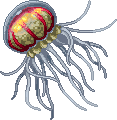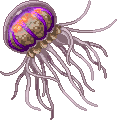



General
The oceans are full of many colorful jellyfish, but nhirudos are among the most striking. The gold patches on their bodies can produce fluorescent light, attracting prey to their tentacles, which are covered in stinging nematocysts. Like all jellies and their relatives, nhirudos inject venom through little needle-like structures in these cells. The venom is powerful enough to kill tiny creatures, but these jellies prefer to latch onto much larger prey. Unique among jellies, nhirudos will embed the barbs of its nematocysts into larger creatures and use them to suck the blood directly from its victims veins. The venom numbs the area, preventing the host from realizing the nhirudo has grabbed it. Eventually, the jelly will drink its fill and fall off like a tick or leech, often having grown much brighter in color because of its blood meal. If the jelly has eaten from an especially magical creature, it will often develop a purplish tinge. Drinking the blood of magical creatures doesn't seem to have much direct effect on the jellies, as they can't actively pursue creatures and mainly latch onto whatever they bump into, but nhirudos do seem to drink for longer when attached to magical creatures.
Egg
The tiny barbs on this plain egg's shell prick your fingers every time you touch it.
Hatchling
The planulae of a nhirudo are each about the width of a fingernail, which may not sound especially impressive, but makes them quite large compared to other larval jellies. They retain their stinging nematocysts throughout their lives, initially using them for defense, and later to feed. Nhirudos, like other jellies, have unusually complex life cycles. After a planula hatches, it searches for a spot on a rough surface to form a polyp, which looks almost plant-like. The polyp has a simple root to anchor it to rocks, corals, or, occasionally, living creatures. It feeds on plankton floating past until it's ready to begin the next phase of its life cycle. At that point, the polyp can start to bud into smaller free-floating jellies called ephyra. The ephyra of a nhirudo closely resemble the planula stage, but are much larger and more mobile. Eventually, these will grow into fully-formed jellies.
Adult
Nhirudos are mostly benign when they're small, unable to spread disease and likely to fall off after feeding for just a few hours. However, these jellies continue to grow throughout their lifetimes, reaching alarming sizes in some parts of the world. Some individuals thought to be hundreds of years old have bells in excess of thirty feet in diameter and tentacles over a thousand feet long. These exceedingly rare enormous nhirudos live in the deep trenches of the world and only need to feed about once per year. When they do feed, though, they'll eat animals the size of whales without hesitation. At that size, few creatures can survive the billions of tiny stinging cells that inject potent venom, and those that can are still drained dry within an hour of being tangled in the tentacles. No humans have ever been taken by one of these jellies, but that's likely due to the difficulty in reaching the giant forms. Smaller nhirudos are regularly encountered at the surface and give itchy stings, but are mostly considered harmless. Still, those with blood-clotting illnesses and allergies to insects are encouraged to keep away from these vibrant invertebrates.
Notes
Obtained from: Event, Halloween, Retired
Breeding: Yes
Renaming cost: 200 gold
Release date: October 25th 2018
Element: Neutral 
Breeds with the following:
Nhirudo + Nhirudo = Nhirudo (Normal)
Halloween 2018 event creature
Can be transformed to shiny sprite.
Sprite art: Tekla | Description: PKGriffin